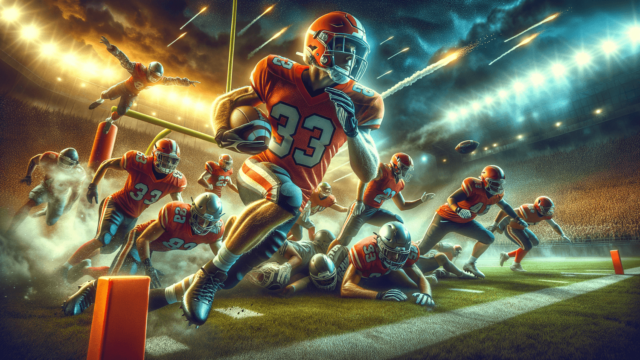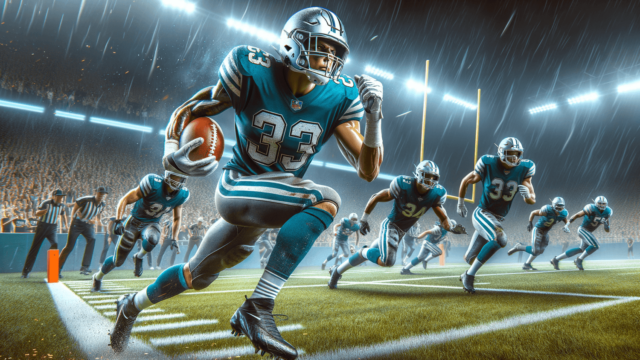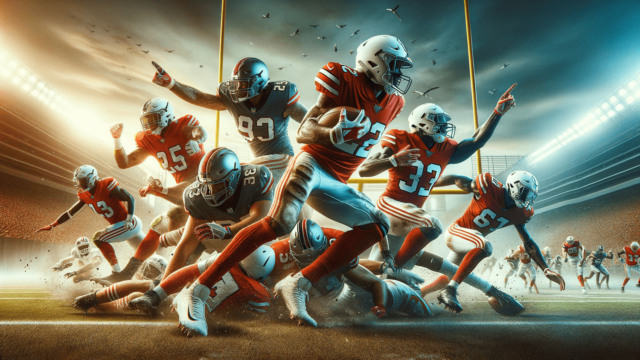
A stick route in football is a short, quick pass pattern where a receiver runs straight up the field for around 5-10 yards before turning sharply towards the sideline (outside) or quarterback (inside). Usually executed by slot receivers or tight ends, it aims to exploit potential weaknesses in the defense while providing a high-percentage completion option for the quarterback.
Understanding the Stick Route in Football
The stick route is a fundamental pass pattern frequently utilized in football to create an efficient and high-percentage completion opportunity for the offense. This route primarily involves receivers, tight ends, or running backs serving as viable passing options for the quarterback.
Executing the Stick Route
During the stick route:
- Receivers run straight down the field for about 5-10 yards.
- Depending on the defensive coverage, receivers either turn sharply towards the sideline (outside) or quarterback (inside).
- The quarterback must accurately assess the coverage and throw to the open receiver at the precise moment they break into the route.
Role of the Receiver in the Stick Route
Receivers executing the stick route play a key role in ensuring its success. They must be quick off the line, run crisp routes, and make intelligent decisions based on the defense’s coverage. Reading the correct time to make a cut according to the defensive alignment is crucial, as is maintaining a strong awareness of the sideline to avoid stepping out of bounds.
Role of the Quarterback in the Stick Route
The quarterback’s role during the stick route is to quickly identify the open receiver and make an accurate, well-timed throw. The quarterback should be prepared for multiple adjustments based on the defense’s coverage, delivering the ball swiftly to the targeted receiver for an efficient gain.
Advantages of the Stick Route in Football
Implementing the stick route in a football play can yield several benefits:
- Exploiting weaknesses in the defense: Quick cuts by the receiver may create mismatches against zone coverage or force man-to-man defenders out of position.
- High-percentage completion: Due to its short distance, the stick route often results in a completions and a positive gain in yards.
- Helps open up the field: By successfully executing stick routes, the offense can force the defense to allocate resources against the short pass, hence potentially creating opportunities for deeper routes in later plays.
Variations of the Stick Route
While the stick route is already a powerful offensive tool in football, there are a few variations and combinations that can make it even more effective:
- Stick-Nod Route: In this play, the receiver fakes an inside break or “nod” before continuing vertically down the field. This can deceive defenders into biting on the fake and opening up space for a longer pass.
- Stick-Option Route: As the name suggests, this variant gives the receiver the option to either execute the traditional stick route or break inside, depending on the positioning and movement of the defenders.
Defending Against the Stick Route in Football
Even though the stick route is a high-percentage play, there are defensive strategies that can limit its effectiveness:
- Press coverage: Defenders can line up close to the line of scrimmage and jam the receiver to disrupt the timing of the route.
- Bump and run: Defensive backs can attempt to bump receivers as they release and then run with them down the field, diminishing the separation that the receiver may create.
- Aggressive zone coverage: Defenders can be more aggressive when in zone coverage, anticipating the receiver’s break and closing on the ball quickly when the pass is thrown.
Examples of Stick Route in Popular Schemes
The stick route is an essential part of many offensive schemes in football, such as:
- West Coast Offense: As a quick, high-percentage concept, the stick route is much favored by West Coast Offense practitioners. The route helps set the stage for further options, such as play-action plays or deeper routes.
- Spread Offense: While the Spread Offense emphasizes passing to the perimeter, the stick route provides a reliable underneath option that can exploit defensive attention on further downfield threats.
Frequently Asked Questions
In this section, we will answer some of the most common questions regarding the stick route and its various aspects, providing clear and concise information for a better understanding of this offensive concept in football.
What distinguishes a stick route from other passing routes?
A stick route is characterized by its short distance, quick cut towards the sideline or quarterback, and its high-percentage completion rate. It offers a reliable option for the offense, exploiting weaknesses in the defense and creating opportunities for more complex offensive schemes.
When should an offensive team employ the stick route?
Offensive teams should use the stick route when they need a quick and efficient passing option with a high probability of success. The stick route can be used in different situations, such as when facing zone coverage, facing man-to-man coverage, or exploiting mismatches between receivers and defenders.
In what formations does the stick route work best?
The stick route is compatible with various formations, but it is especially effective in the West Coast and Spread Offenses. These offensive schemes prioritize short, quick passes and emphasize spacing the defense, making the stick route a valuable tool for gaining positive yards and sustaining drives.
Can running backs and tight ends also run the stick route?
Yes, running backs and tight ends can also run the stick route. Although it is traditionally executed by wide receivers, running backs and tight ends can be successful in this route due to their similar abilities to be quick and agile while attacking the defense.
Is it possible to perform a stick route while running play-action?
Yes, a stick route can be combined with play-action plays. By faking a run during play-action, the offense can potentially lure defenders up towards the line of scrimmage, which creates an opportunity for executing a successful stick route in the vacated space behind the drawn-in defenders.
Featured Posts
- No pillar pages found.





